Owing to the screen size of your device, you may obtain a better viewing experience by
rotating your device a quarter-turn (to get the so-called "panorama" screen view).
|
This page updated for 2022.
|
Click here for the site directory.
|
|
Please consider linking to this site!
|
Click here to email us.
|
Salad Greens
[This page deals only with salad greens; the leafy greens we find useful for cooking purposes—Spinach, Swiss Chard, Kale, and Broccoli Raab—each have a page of their own—though some of the greens discussed here for salad use can also be used cooked.]
About Salad Greens
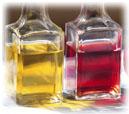
Salad greens—other than lettuces, which we treat elsewhere—serve two purposes: they can provide visual variety, and thus interest, owing to non-green colors or interesting shapes; and they can provide some taste variety (having often to cut through a dressing to be noticed, that’s usually some strong—typically bitter—sort of taste, which many people like, at least in moderation, as an accent). “Greens” that are not either visually interesting or piquant are largely valueless. (One might call nutrition a third purpose, as many greens have much more nutritional value than lettuces, but we do not select our food for its nutritional value—we feel that if you eat a broad spectrum of vegetables, you’re doing just fine without picking and choosing.)
(A vegetable that can be used as simply a salad green but which—with us—qualifies as a great vegetable is sorrel, and we are not alone there: Germiny a L’Oseille—which is just cream of sorrel soup—is almost universally called the Queen of Soups. As with spinach and parsley, two other sometime “salad greens”, we list sorrel on its own page and so do not discuss it here.)
One needs, before starting to collect miscellaneous salad greens, to keep a few things in mind:
Having a good variety of lettuce types available covers much of the “visual interest” ground—reds, greens; flat-leaf, curled-leaf, frizzy leaf; and so on.
Just radishes, carrots, and sweet peppers can add a lot of color and “bite” to salads; so also—as noted above—can sorrel and spinach.
A number of the things we already grow as cooking herbs are also suited for use as garnishes or actual ingredients in salads—things like leaf parsley.
Many greens used for salad sharpness are Brassicas, and thus a huge nuisance in the garden because they cannot be grown in the same soil more often than once every four years; our maincrop Brassicas we can rotate with all our other maincrop vegetables, but little extras of that sort would be a first-class nuisance. (Radishes are so small and fast we can grow them indoors in a modest container all their own.)
(The always-useful Cook’s Thesaurus provides a load of photographs of various salad makings.)
Nowadays, there is a host of non-lettuce greens of greater or lesser note used in salads, in good part, we feel, because nowadays it is very chi-chi to serve a “mesclun” salad whose quality seems—in social terms anyway—to be determined primarily by the sheer number of different things in it, and secondarily by the obscurity of those things. We have, with an effort, tried to wrench ourselves out of that “stamp-collector” mode, and correspondingly have tried to focus on those few “greens” that we think will really add something distinctive to salads, though we will certainly be doing some experimenting, too.
We should further note that many gardeners feel that mid-summer and mid-winter are “dead zones” for lettuces, and thus that alternative greens are needed if salads are to be had; in summer, they grow things like leaf amaranth, in winter things like kale. We, having copious indoor growing space, are going to take a shot at growing lettuce indoors in containers year round (it takes a lot of containers, succession planted, to get a continuing supply).
If indoor growing somehow doesn’t pan out—or for those without so much space—we, in our climate (and probably you, too), should, by judicious cultivar selection and some commonsense measures regarding our lettuce-growing areas (see the page on lettuce), be able to get decent lettuce year round.
Also, not exactly “salad stuffs”, but excellent additions to many salads for both color and taste are the leaves of edible flowers, which number more than you might think (though not all—never eat any flower you aren’t sure is safe to eat, as some are actually poisonous). At the least, one should have some nasturtiums going. (They are also good growing companions for many vegetables.)
In earlier years, before common sense had its say, we had planned all sorts of greens we now see little or no need for, but—since we did the spadework—we leave in here the information on them for others whose tastes and opinions on what’s wanted for salad greens differ from ours.
The salad stuffs we ourselves now intend to grow, besides lettuces and the veggies and herbs mentioned above, are:
But we also describe several other popular greens we just happen not to be growing ourselves.
Year Round Greens
Caucasian Mountain Spinach (Hablitzia tamnoides)
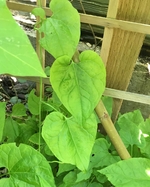
This plant has an old heritage, but seems only newly discovered in the U.S. It is a perennial (up to a half-century), reported hardy down to Zone 3, and a climber (up to as much as 10 feet, though 6 to 9 is more common— in some places, notably Sweden, its climbing habit and its delightful appearance has made it a popular house “screening” plant). Its European home was the understory of temperate Caucasus Mountain forests, so there is a very good chance that this veggie will be one of the very few that can grow and thrive in heavy shade. Indeed, it is said that leaves grown in shade are more tender than those grown in sun.
It is a very slow starter: general recommendations are to: 1) cold-stratify the seeds for at least a month; 2) plant a lot of seeds, because they are finicky herminators; and 3) keep such seedlings as you do get in a one-gallon pot for their first year of growth before transplanting to a permanent location. (Those wooden half-barrels so widely available make a nice home for one of these—and one is all you’d likely ever need once it gets established; just put a trellis behind it.)
Reportedly there is no bitterness to the leaves even when they get old—though old leaves are better cooked while younger leaves are supposed to be great raw. Also, besides the leaves (which can be up to 9 inches long), there are the green shoots available in the spring: they, too, are said to be great eating. (“Great” may be enthusiasm: they are basically greens, none of which really have all that much flavor, and which thus rely on what you put on them for most of their appeal.)
One set of recommendations from a commercial grower:
The best way to germinate seeds…is to plant them just below the surface of moist seed starting mix in a small, covered dish and place that in the refrigerator. The seeds will sprout within about a month, at which point they should be removed from the fridge and brought outside (but watch they don’t get fried in the sun those first few days). Seeds require cool temperatures to germinate. If they don’t sprout after a month, take them outside anyway, and they will probably sprout soon after. Young seedlings are tiny and fragile, and shouldn’t be allowed to dry out or overheat. Plants will be small their first year, but will grow larger in each subsequent year, eventually forming a big clump. Put in a location where they can climb extensively.
Another source says “rather than putting a container of soil planted with those seeds in your refrigerator, just plant them in a container of moist plant mix that you can leave in a protected place outdoors. Let Mother Nature lend her talent at stratification, which some could call chilling treatment.” If you start in winter, that should work.
Caucasian Mountain Spinach wants deep-loam soil with good drainage (it dislikes excess moisture). All in all, this promises to be a really fine addition to the home gardener’s arsenal of year-round greens.
Some useful Caucasian Mountain Spinach links:
Cress
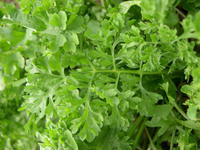
|
There are several plants called “cress”, not all closely related but all grown for the same uses and superficially similar in appearance and culinary values. They include (at the least):
- watercress, Rorippa nasturtium, perhaps the best-known cress
- land cress, Barbarea verna, also known as Belle Isle cress, Early yellowrocket, American cress, dryland cress, upland cress, cassabully, creasy salad, Early winter cress, American cress, and American watercress
- garden cress, Lepidium sativum, also commonly known as garden pepper cress, pepper grass, pepperwort, and Persian cress
|
The cress we use and recommend has the charming name Wrinkled Crinkled Crumpled Cress; it’s a fairly new selection that was selected out by Frank Morton of Wild Garden Seeds from an on-farm cross between “Persian” and “Curly” cress—which leaves us with no idea of just what it’s correct botanical classification is, though seedsmen are listing it as a Lepidium sativum “garden cress”type.
Besides having somewhat superior culinary qualities, it is reportedly about the most bolt-resistant cress out there: one grower reported that it “thrived in 6 weeks of continuous rain last year, and this year thrived in basically a month of drought and temperatures at 80°-90°F.” In our climate, this variety should be growable outdoors year round; direct-seed it as soon as the ground can be worked, and continue sowing every two weeks or so till the ground freezes up for the winter. In the warmest months, try to provide it some shade.
Or, you can opt to grow it indoors in a container, where it is possibly the easiest of all vegetables to grow: basically scatter the seeds on a shallow tray with some soil in it, water, and harvest (re-seed every couple of weeks).
Outdoors or in, harvest some whenever you feel the leaves are large enough to be useful (probably a good idea to not let the plant get over 6" high). Cress can be treated as a cut-and-come-again crop—take only a few leaves from each plant at any one time, to encourage further growth.
Besides going into salads, cress can be used to spice up sandwiches, so grow a good bit.
Some useful Cress links:
Lovage (Levisticum officinale)
See the Lovage page in our Herbs section.
Minutina (Plantago coronopus))
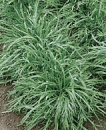
(This is not a plant we grow or have grown ourselves; we have nothing against it—it’s just a matter of variety overload.)
Minutina, known in Europe as herba stella or erba stella (star herb) and also in the English-speaking world as buckshorn (or buckhorn) plantain, is an increasingly popular salad green. It is said to have a “mild, sweet” flavor (also described as “almost salty”), though perhaps its main charm is its shape and appearance (blade-like with small, serrated leaves, good, toothsome crunch).
Although favored as a winter green owing to its cold-tolerance (though it might not make it through the coldest depths of winter), minutina also grows fairly well in summer, too, without becoming bitter. Sow the seed in place in either spring or autumn; seed it at about 6 inches—or perhaps 4 inches for deep-dug beds. Pick it when it is young and tender, perhaps at 5 inches, else it may just flop over and rot. Watering is a bit touchy: you need to water it well to maintain the wanted succulence of its tender leaves; but if you over-water it, it will flop over and rot as if grown too tall, while if you under-water it, it will wilt and dry up. Just keep a careful eye on it day to day till you get a sense for what keeps it looking healthy.
Though some say it has a long tap root, others seem to grow it without problem in small to medium pots.
Miner’s Lettuce (Montia perfoliata, formerly Claytonia perfoliata)

This stuff is nearly tasteless, but is quite pretty and well worth growing for its visual appeal in a salad. There are numerous edible Montia/Claytonia species, all in the Portulacaceae family—the purslanes. It ought to grow wild around here wherever there is some of the shade it likes, but we haven’t noticed any (but we haven’t exactly been out scouring the trails, either). There are no named cultivars (that we saw).
Miner’s lettuce is not frost tender: indeed, it is commonly in leaf all year (and in in flower from May to July). It is notably tolerant of almost any soil conditions. As is common with greens, the young leaves are the best; older leaves can turn bitter, especially in the summer and most especially if the plant is growing in a hot, dry position. While individual leaves are rather small, the plant produces extravagantly. And besides the leaves, you can use the stalks and flowers as well. In summer, it likes—indeed, may require—some shade.
One source (linked below) says: Growing claytonia is ridiculously easy. It is not fussy about soil, asking only consistent moisture. You might even plant it in the shade of a deciduous tree where other garden crops might languish. It will receive the sun it needs after the tree’s leaves fall. Though the seeds are tiny, try to sow them sparsely so you don’t have to thin them later. Rip out the plants promptly when they start to set seed (they’re easy to pull up). Otherwise, you will have a galaxy of claytonia plants the following year, and not necessarily where you want them. On the other hand, letting a few plants self-sow in the bed may prove a handy way to ensure a yearly supply of this elfin crop for your winter table.
It seems to germinate best in the later autumn.
Here’s the full article, from the Washington Post, whence that information.
This also can be grown in a pot (well, a tray actually) indoors, rather like cress.
Some useful Miner’s Lettuce links:
Burnet (Sanguisorba minor)
Aka Salad Burnet. See the Burnet page in our Herbs section.
Dandelion, French (Taraxacum officinale)
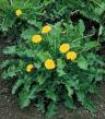
(This is not a plant we grow or have grown ourselves; we have nothing against it—it’s just a matter of variety overload.)
The culinary dandelion is only a somewhat improved selection from the wild dandelion, the same thing that keeps suburbanites with lawns from sleeping well. It makes a garnish for salads for those with a definite taste for bitterness; all others would be well advised to use it quite sparingly (if at all).
(The word “dandelion” is a corruption of the French phrase dent de lion—“lion’s tooth”—a term for the plant deriving from the toothed appearance of its stems. Do not confuse the true French culinary dandelion with the Italian Catalogna chicory, too often marketed by seedsmen as “Italian dandelion”.)
Considering its heritage, the dandelion—like many of the weedy salad greens—should be well guarded against going to seed. While no place whatever is likely to be exactly free of dandelions, you don’t want to be responsible for a sudden major infestation, on your property or anyone else’s.
Curiously, so much taken for granted is the dandelion’s viability that actual growing information is hard to find. That old standby, A Modern Herbal (1931) by Mrs. M. Grieve, states:
The seed of a special broad-leaved variety of Dandelion is sold by seedsmen for cultivation for salad purposes. Dandelion can be blanched in the same way as endive, and is then very delicate in flavour. If covered with an ordinary flower-pot during the winter, the pot being further buried under some rough stable litter, the young leaves sprout when there is a dearth of saladings and prove a welcome change in early spring. Cultivated thus, Dandelion is only pleasantly bitter, and if eaten while the leaves are quite young, the centre rib of the leaf is not at all unpleasant to the taste. When older the rib is tough and not nice to eat. If the flower-buds of plants reserved in a corner of the garden for salad purposes are removed at once and the leaves carefully cut, the plants will last through the whole winter. [emphasis added]
One presumes, then, that initial seeding is best accomplished in early spring, with frequent succession seeding thereafter. The growth pattern is simple enough: the first edible portion to appear is a reddish tangle of leaves, from which the greens will then grow—those being the leaves above the surface. They must be gathered before the plant blooms to be culinarily useful. The best time to gather them is just when the bloom bud appears and before the stalk grows, else they will be too bitter even for fans of bitterness. And you need to cut them down before they can bloom.
Once a given plant (you scarcely need a fieldful of them) is well established, a quick process, cover it with straw (or, as mentioned above, an upturned pot) for a couple of weeks, then harvest the blanched leaves; the blanching should produce leaves of a whitish-yellow and—most important—modulate their inherent bitterness. When using your harvested leaves, the sources all say to gently tear the leaves rather cut them, so as to retain the flavor.
You can try following Mrs. Grieve’s advice to see if you can maintain a growth right through the winter.
Cool-Weather Greens
These are things that simply will not grow in summer’s heat, but will do fine in the other three seasons; they are invaluable in winter.
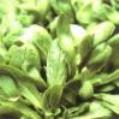
This fashionable relative of valerian goes by many names: corn salad, mâche, lamb’s lettuce, lamb’s tongue, field lettuce, field salad, rapunzel, doucette, loblollie, and fetticus (but do not confuse it with “lamb’s quarters”, a completely different green). It is a rather mild-flavored green, often said to have a somewhat “nut-like” taste quality. Though most greens we consider to be additions to salads, mâche can make a small salad on its own when a few tangy bits—such as, for example, some sharp cheese, or some walnuts, or perhaps some zingy citrus slices—are added in. (The French like it with some cooked-beet slices, walnuts, and a dressing with walnut oil.)
Mâche is commonly called a cool-weather plant, and it certainly is: it can literally be harvested through snow (it’s said to be safe down to about -5°F, probably a deal more with some protection. (Mulch it in the winter, with straw or the like.) But there are also types that can withstand some heat.
The basic distinction in cultivars is between “large-seeded” and “small-seeded”: small-seeded are for cold weather, large-seeded for warm weather (it is unclear if there are any material differences in cultivars within those two types). It seems agreed that the large-seeded types have better flavor than the small-seeded, but if you want winter greens you have no real choice.
To get mâche in warm weather, be sure to seed before soil temperatures go above about 65°F. (The soil-temperature range for seeding mâche is well-defined: 41°F to 67°F—though some put the floor as high as 50°F; it is probably useless to try sowing outside that range.
It is said that mâche will bolt at daytime air temperatures of about 80°F. (which, for us, is around middle to late June). We can resume fall plantings in middle to late August; with a growth period of about 40 to 70 days, that means we can have fresh mâche from roughly late October through late June, about nine months of the year. But in both cool weather and warm weather, it makes sense to succession plant. (The division of when to switch from a small-seeded variety—what we start with in August—to large-seeded is vague, but is probably around April 1st.
It is thus wise to allocate permanent space for several plants. The plant does not need much space, and a frequent recommendation is to just scatter seed, coat it very lightly with hand-sifted soil, and let it do its thing (and it self-seeds extravagantly). But allocate separate little spaces and succession seed.
If you detect a flower stalk starting on a corn-salad plant, pull the plant right then, as it is about to become useless. In summer, providing some shade might slow down the bolting process.
Corn salad likes a loose soil, preferably a bit sandy, but is generally counted easy to grow, though—beware—the germination rate can be rather low. Also, mâche does not like to be transplanted, of fussed with much at all till it’s about ready for harvest, so wait for the leaves to be of a modest size before cutting.
If, in winter, you harvest just the outer leaves, the plant will keep producing through the winter, though slowly. If, in summer, you allow the plants to bolt, they will self-seed, making your planting essentially perennial.
There are relatively many cultivars available for this green—world-wide, perhaps five dozen, though far fewer are available in North America (counting is complicated by there being several names for most kinds). You would want to plant a small-seeded variety till you come into warmer weather, then start seeding a large-seeded cultivar. Recommendations for both types are several and varied. One that shows up a lot is Piedmont, a large-seeded type that nevertheless seems to endure winters well. Another frequently mentioned is Vit (beware: the name is also a generic alias for corn salad in general), a small-seeded variety. More classic types are Verte de Cambrai, a small-seeded heirloom, and Large-Leaf Round, obviously a large-seeded type and also an heirloom. We suspect that you would do well with any of those; forced to choose, we’d likely go with Piedmont and Vit, but we could about as easily instead go with Verte de Cambrai and Large-Leaf Round. Ya pays yer money an’ ya takes yer chances…
Some useful Corn Salad links:
Radicchio (Cichorium intybus
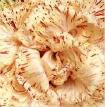
(This is not a plant we grow or have grown ourselves; we have nothing against it—it’s just a matter of variety overload.)
Radicchio, aka red chicory, red-leafed chicory, red Italian chicory, chioggia: the colors are delightful. The leaves are somewhat bitter, but sweeten slightly in the cooler day temperatures of autumn. Radicchio is just a chicory that is red (or red-spotted) and tends to head. There are numerous cultivars (we counted to 21 before we gave up), all touted by someone, somewhere, for something. In commercial use, the chief determinant of “quality” is the percentage of plants that head, for radicchio is notoriously low-producing; we home gardeners, growing just for our tables, don’t care: we can and do sow several seeds for each plant wanted, and just don’t plant out the runts. After seemingly endless hours scouring the literature, we reckon the types Castelfranco Variegated (aka Variegata Castelfranco and Castelfranco Valdamo), a semi-heading type with a less-traditional coloring, a beauty (that’s it at the left), and Palla Rosso, a more traditionally colored type, seem the best to try as a beginning.
Radicchio is grown much like lettuce, though it takes rather longer to mature (80 to 85 days). It is moderately frost-hardy: tops will reportedly withstand temperatures down to 20°F. or so, at least for short periods. While it can be grown through fairly warm, or even hot, weather, plants that mature in such conditions are excessively bitter, so such growing is ill-advised. With care, though (such as “hoop greenhouses”), radicchio—again like lettuce—very probably can be grown throughout the winter in climates that, like ours, are not excessively cold. (In fact, a well-known book, Four-Season Harvest, by Eliot Coleman, describes winter gardening in Maine!) Radicchio can withstand some shade, and may even prefer it when it is warm; it is also said to do well in containers.
Timing seeding for radicchio is tricky in our climate, owing to the need to avoid growing it in summer heat—we need our spring-planted crop out by, say, mid-June, to avoid temperatures over 80°F. or so; that means—for direct-seeding—planting literally “as soon as the ground can be worked” in the spring, say March 1st or so. (The drawback is, of course, that all the spring-planted radicchio, since we can’t plant much earlier or later than that, will come ready nearly all at once.) But, as radicchio will grow well even in quite cold weather, possibly right through the winter with some care, we can start seeding again in late summer—July seems generally suggested as the time to start (early if it’s a cool summer, later in the month if not). From that date, we can keep on succession-seeding at a rate determined by our available space and our need for the plant. If winter growing is indeed practicable, then we just keep seeding till mid-March or so.
Being smaller than lettuce, radicchio can be spaced at 6 inches in a well-dug bed, giving four plants to the square foot. Germination is usually rapid, a week or less, with the ideal soil temperature being 60°F. to 65°F. Be aware that radicchio is notoriously low-germinating. For home gardeners not planting fieldsful of the stuff, the solution is to just generously multiple-seed for each wanted plant.
Whatever you do, do not allow growing radicchio to dry out or you will end up with an inedibly bitter disaster. Radicchio is shallow-rooted: it is best to water moderately but frequently, rather than to give large amounts occasionally.
As with all our greens, we want to pick radicchio when it is still young and not only tender, but not yet too bitter. We grow it for its beauty and its somewhat bitter quality, but we don’t want a chokingly over-bitter end product. Do not judge maturity by the size of the typical supermarket radicchio, which is almost always grossly over-grown; one source suggested picking when the heads are about the size of a large orange. (If you are growing a leafy cultivar, rather than a heading type, you can of course use the cut-and-come-again approach.)
If your culinary life depends on having radicchio available all the time, you could grow some indoors in pots during the summer months (allowing appropriate backtiming to figure when to seed them); they are supposed to do well in pots.
Escarole (Cichorium endivia)
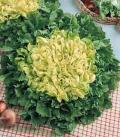
(This is not a plant we grow or have grown ourselves; we have nothing against it—it’s just a matter of variety overload.)
There can be a deal of terminological confusion about the group of greens that includes “escarole”, because they are all closely related and in the chicory family; moreover, “escarole” (also called Batavian or Batavian endive) scarcely differs from endive (they are the same species) save in appearance and growth habit, being “bushier” (that is, it has leaves and heads, rather like lettuce). Like its cousins, it is somewhat on the bitter side, and is best used as a source of additions to salads than as a salad basis in itself, particularly relying on the more tender inner leaves. (But the outer leaves can be cooked, and go well in some soups and stews.)
Escarole is a rather slow-growing vegetable—typically 90 days to maturity, so—it being a cold-weather crop—spring plantings are pretty much right out. Fortunately, escarole can withstand pretty low temperatures, so one can probably, with due care, grow it through the winter hereabouts (or, as the Coleman book cited above suggests, anywhere). Begin seeding in mid-July or so, and keep on till, well, who knows? Into March, one would think, for sure, and possibly till April (which would mean harvest till the end of June).
Culture is much like that for lettuce, with the same one square foot allocated per plant. We feel that one or at most two plants will suffice for anyone not a fanatic, since you can take leaves as needed on the standard cut-and-come-again basis. Be sure to water frequently: water stress can greatly increase bitterness.
Where spring days can be cool, as they can here, young plants can bolt in the spring; a stretch of, say, 10 days of weather not over 50°F. or so when the plants are in the four- to five-leaf stage will trigger bloom and render the plant useless. At that time of year, then, provide some cold protection—Walls o’ Water, cold frames, row cover, something of that sort. (Long days will also trigger bloom, so no escarole, or endive, will grow from spring through summer.)
(Escarole can be “blanched” during its later growth, but that seems—to us, anyway—a quite needless waste of time and work.)
In selecting a cultivar, we end up being driven primarily by toleration to temperature, inasmuch as there is no meaningful information available on culinary distinctions (if any) from one type to another. Even here, one is torn between extremes: get a cold-resistant type, to try to make it all the way through winter? Or get a “slow-bolt” type to try to make it deeper into the spring and early summer? We would opt for cold resistance, but you need to make your own judgement; the type we’d trial is Ascolana, pictured a little above on the right (you can plainly see the traditional distinction between “inner” and “outer” escarole leaves). Other good-sounding candidates are:
- Grosse Bouclee - slow bolting
- Florida Full Heart - large, spreading, but with dense, blanched inner head
- Batavian (also a name used generically for escaroles)
- Nuvol - especially recommended for spring planting; slightly smaller head and more crumpled leaves than full-heart types
- Coronet D’Anjou - heirloom; looks more like iceberg lettuce than standard escarole
(To see a lot of escarole/endive types you probably never heard of, try the endive-seed page
of the Gourmet Seed company, which carries a lot of Italian types and seeds, or of Seeds From Italy,
ditto.)
Here is an essay on the chicory/endive greens that goes into the confusion over names in the group.
Chicory (Cichorium intybus)
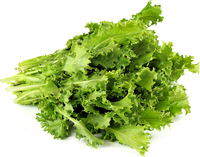
(This is not a plant we grow or have grown ourselves; we have nothing against it—it’s just a matter of variety overload.)
Chicory is very similar in general to escarole, described above, save for its appearance; the characteristic Italian type, that of frizzy stalks (as shown on the left) is commonly called “Catalogna”. In flavor, it is pretty much like escarole and even radicchio (though, as a stalk, it is a bit crunchier to the tooth); it is for their differing appearances and textures that one grows more than one of these mildly bitter garnishes. In any event, virtually all the comments above about escarole apply with equal force to endive.
The Catalogna-type chicory shown here, which is the prettiest for salads, is sometimes also called “Italian dandelion”, but it’s not a dandelion, nor is it related to dandelions (also, extra-confusingly, culinary dandelions are often called “Catalogna” in catalogues). There are named chicory varieties, even within the Catalogna type, but no information we could find outside a few specialist seedsmen’s catalogues—which we consider unreliable sources—about differences in taste or productivity: pick a seedsman and go with it.
What we’d go with is a type called Romanesco da Taglio (shown at the right).
Warm-Weather Greens
Most traditional salad greens are, like lettuce itself, cool-weather fans, so in warm weather we are often, to some extent, improvising. Moreover, in mid-summer, when the supply of lettuce itself may diminish, salad greens can not only add interest to a salad, they can eke out its actual bulk by partially (or even wholly) replacing lettuces.
Purslane (Portulaca oleracea)
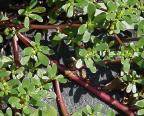
Like so many interesting—and, in other lands, treasured—salad greens, in the U.S. purslane is thought of mostly as a weed (little hogweed—also pusley, pussly, kitchen purslane, garden purslane, and fatweed.). It is described as having a “mild, sweet-sour” flavor with a peppery overtone, and a chewy texture. In Europe, the succulent leaves and young shoots are used in spring salads, the older shoots as a pot-herb, and the thick stems of plants that have run to seed are pickled in salt and vinegar for winter salads. Purslane is a potherb, and so can also be cooked; like Malabar spinach (described below) or okra, its mucilaginous quality is great for thickening soups and stews. (Here is the epicurious page on What to Do With Purslane.)
Purslane is available from seedsmen in two basic types: green and golden. Some say that golden purslane is P. sativa, while only green is P. oleracea; it is also said that only the golden type comes true from seed. In any event, there seems to be no culinary distinction between the two.
Purslane is very easy to grow—again, far too easy, for it quickly invades and becomes an ineradicable weed (the 7th worst in the world); even a small bit of stem will root and grow. It thus makes excellent sense to keep purslane growing in a pot (and never throw any least part of a purslane plant where it might take root, such as a compost heap, or even a sidewalk—purslane notoriously takes over the cracks in paving). It is very heat-tolerant and drought-tolerant, though if you are growing it, you want to keep it well watered to maintain its succulence.
Plant by basically just strewing the seed where you want it (again, very much preferably in a pot); it can be allowed to grow rather densely, say to a 3-inch spacing. Purslane much prefers a sunny location. It is low-growing, and tends to trail; a pot can thus be hung, and the plant allowed to trail (but mind, don’t let it reach the ground or it’ll root there!). You can start sowing as soon as it is no longer really cold; purslane plants tend to last about 3 months, so you may want to re-seed in mid-summer, or even every couple of weeks, depending on how much you take how often. Fall cold will kill the plants back.
Take purslane for fresh eating only when the plant is young—the flavor deteriorates badly once it starts to bloom. You can take whole branches (the stems are perfectly edible) till blossoms appear, at which point you can pull the plant or leave it for the look of its delightful blossoms (it is commonly grown purely as an ornamental). For preparing whole plants, cut off the root—but then the individual stems needs to be washed carefully (Purslane has little crevices to hold the soil, so you really need to use a hose to get all the dirt off).
(Purslane is an excellent source of a dietary component called alpha-linolenic acid, one of the Omega-3 fatty acids now thought to be critically important to human health, and undersupplied in most people’s diets; almost the only other rich source of Omega-3 fatty acids is cold-water fish, such as salmon, a source that is impossible for vegetarians and not easily made a large part of the diet by anyone. Regularly adding nontrivial amounts of purslane to salads is an easy way to get useful amounts of Omega-3 fatty acids into one’s diet.)
Some other useful Purslane links:
Amaranth
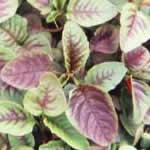
(This is not a plant we grow or have grown ourselves; we have nothing against it—it’s just a matter of variety overload.)
Amaranth can be grown for either its seed, which is used like a grain, or for its leaf, which is a potherb. Although any variety will do for either use, certain kinds have been developed that are somewhat better for one use than the other. (As a green, amaranth leaf is sometimes known as “Chinese spinach”—not to be confused with “Malabar spinach”, yet another leafy green—or as “Callaloo”.) Amaranth is also occasionally grown for its floral value, in particular a type known as "Joseph’s coat".
(While we discuss amaranth here only as a green, its highly nutritous grain—16% protein, compared to 10% for most cereal grains—makes it worth considering as a grain crop for those with some room to spare in their gardens and an urge to experiment.)
The chief value of amaranth to the home gardener is that it is a green that actually prefers hot growing conditions, and is commonly described as easy to grow: indeed, in some areas it is considered a weed—“pigweed”, to be exact). As with most plants described as “potherbs”, the younger, more tender leaves can be eaten raw as additions to salads, while the older, larger leaves need steaming, parboiling, or some similar treatment to be edible (just as with that most popular potherb, spinach). Here, we deal solely with growing it for use raw as a warm-weather salad ingredient.
As we say, we cannot personally report on the eating quality, but it is very widely consumed and appreciated around the world. One gardener, well familiar with the stuff, wrote:
The early flower spikes and the youngest leaves, both of which are slimy, can be eaten raw. . . The early leaves of spring are mild in flavor. Later in the season [you] need to wait for leaves less than five inches or the just sprouted flower bud if [you] want to use them as a uncooked green. . . [T]he large leaves that are so abundant later in the season, along with the leaf stalk, are good as a cooked vegetable if there is a strong flavor to complement the rather bitter, meaty flavor of mature amaranth. . . [T]he young shoots and leaves have a slight lemony taste. . .
That paragraph will explain why there are often such contradictory reports on the taste of amaranth leaves: some say mild and sweet, some say strong and bitter, but in fact the difference is in the age and size of the leaves, which progress from sweet and mild when small to pungent as they get larger. (Another gardener reported that The amaranth I’ve tried for their greens must be picked very young, otherwise they become stringy.)
There are at least 60 species of amaranth, but the kind most commonly grown for its leaf is Amaranthus tricolor. A taste testing of amaranths—how rare a thing!—using five cultivars from three species (A. dubius, A. hybridus, and A. tricolor) put the two A. tricolor cultivars (“Tampala” and “Red”) at the top, though an A. dubius cultivar named “Ibondwe” did fairly well and was especially productive (this in the deep south of the U.S.). It thus looks like any variety clearly identified as Amaranthus tricolor is what is wanted, with an exact selection depending more on appearance and sheer availability. (There are a few other species names that may just be synonyms of A. tricolor, but why fool around? There are enough seedsmen offering clearly labelled Tricolors.)
Growing amaranth is easy. In fact, it is, in a sense, too easy: the plant is highly invasive, and—especially in rural areas—it should be an absolute requirement that the gardener be sure to pull out all amaranth plants before they can possibly release seed (or you may be in deep, uh, water with your local noxious-weeds control board!). If you are growing amaranth only for fresh greens—not cooking greens or seed—a spacing of 6 inches quite suffices in a deep-dug garden bed.
Amaranth keeps on flowering until hit by the first hard frost, but seed normally ripens many weeks before that—usually at about three months. It is thus best to pull plants well before that, say at two months or so. If you use a single square foot of garden space, you can seed another plant every month or so and have plants through till frost—for salad garnish, you don’t need much in the way of leaves.)
Some types are said to be mildly frost-hardy, but this is definitely a warm-weather plant, so simply direct-seed it when the likelihood of frost is past—say (in our area) from June 1 on (best germination reportedly occurs at soil temperatures from 65°F to 75°F). As noted above, that succession-sowing a few plants is wise, because, owing to the seed-escape risk, you don’t want any one getting too mature. Since you can put 4 amaranths in a one-square-foot block, that should be no problem. (Most salad plants tend to want a square foot each.)
Orach (Atriplex hortensis)

(This is a plant we grown ourselves, but no longer do; it was ok—it’s just a matter of variety overload.)
Orach—much more commonly grown and used in Europe than in the U.S.—is commonly described as “mild” and “spinach-like” in taste; it is also known as “mountain spinach”, “French spinach”, “sea purslane”, and “butter leaves”.
Though there seem no named cultivars, there are three general varieties: red, green, and white. There is some indication that red is culinarily inferior to the other two, of which white may be slightly superior to green (but red and green are far more commonly offered than white, or a sometimes-cited “golden”, which may be another term for the white variety—so much so that we cannot find seed for anything but red or green.) Nowadays you can buy a color blend commonly called “Aurora”.
(One reference source reports that there are at least 10 orach cultivars available from U.S. seedsmen, but none of the vegetable catalogues we have seen carry cultivar identification—we suspect many of those cultivars are to be found offered as ornamentals in floral catalogues.)
Though orach is nominally a cool-weather crop much like spinach, we list it here because not only will it grow through the summer, it has the excellent quality that—unlike, say, spinch—its leaves do not turn bitter when it bolts, so it will provide useful salad greens till frost kills it off. You can direct-seed it “as soon as the ground can be worked”, as the traditional phrase has it; figure on the usual one square foot per plant. Just take the smaller, younger leaves on an as-wanted basis. Orach is famously tolerant of extreme soil conditions, from acid to alkaline.
Also normal for Orach, as for many potherbs, is its tendency to become an invasive weed, so we repeat the standard advice: do not let any plants drop seed. Better yet—much better—grow it in a container.
New Zealand Spinach (Tetragonia tetragonoides)

(This is a plant we grown ourselves, but no longer do; it was ok—it’s just a matter of variety overload.)
This common warm-weather substitute for real spinach is native to beaches (hence its other name, “sea spinach”—though it is also called at times “warrigal greens”, “botany bay spinach”, or “Cook’s cabbage”). It is used as a direct substitute for its namesake. Cooked, it is virtually indistinguishable, but raw—what we are interested in here—it is not quite the same. As one Australian cook put it, Remember that even though true spinach can be enjoyed raw, New Zealand spinach can’t. Not that it’s indigestible, it just doesn’t taste great; in fact, raw New Zealand spinach doesn’t taste like much at all. Still, it can be used to augment salads, and it can even be used in “spinach salad” recipes if the other makings, and the dressing, add a deal of flavor on their own.
New Zealand spinach is quite hardy once established, but is notoriously troublesome to germinate. Opinions vary on planting: some say it wants warm soil, others say they’ve had better results in cool soil. Take a shot on planting when the soil is cool—if that doesn’t get you a crop, you can just re-seed when the soil has warmed. Before planting, soak the seed in warm water for a full day. Some recommend making a small nick in the hard seed coat, using a pocketknife or the like, just prior to planting. It’s a wise idea to put several seeds at each planting spot, owing to the poor germination rate. Allow the standard greens square foot or so per plant.
Once the plant reaches a modest size, you can begin taking leaves on the usual “cut and come again” basis; the plants should last all season. Even when you don’t have a need for some leaf, keep picking the top 3 to 4 inches of stem, and the leaves as the shoots grow back.
Malabar Spinach (Basella alba)
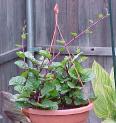
(This is not a plant we grow or have grown ourselves; we have nothing against it—it’s just a matter of variety overload.)
It is surprising that this green is not better known (compared, say, to New Zealand spinach, which you can buy in most any supermarket), in that it is widely reported to be even closer than New Zealand spinach to real spinach, especially raw, and is very easy to grow in even the hottest weather.
Several sources note that the leaves are mucilaginous; a home gardener remarked that you might notice this eating a leaf of it raw in the garden, but not in a salad. It is noteworthy that the leaves are often used in Asia as an ingredient for soup expressly owing to that mucilaginous quality, which makes it a thickener—one immediately thinks of okra and gumbo. Such a use would be an interesting experiment, but its normal intended use remains the augmenting of salad greens in hot weather.
Malabar spinach is a climbing vine, so it needs vertical growth room and support—or it can be grown in a hanging container and allowed to trail. And, though very heat-tolerant, it is correspondingly very frost-tender: night temperatures much below about 50°F on a regular basis are bad for it. This, therefore, is one green that you might consider starting indoors in a pot before transplanting out. As mentioned (and shown here), it can be pot grown, but some gardeners have said that it thrives best in ground. It grows fast enough and high enough to be a decorative cover, albeit an annual one (if you put it away from your main garden, you can let it self-seed, which it reportedly does readily).
When seeding, wait till all risk of frost is past, then plant the seeds a good inch or so deep. Figure (again!) on the greens-traditional square foot or so for ground, but don’t forget to provide something for it to grow up—a trellis or fence. While it can stand some drought, you can scarcely over-water it.
Edible Flowers
A pleasant surprise to many gardeners is the large number of flowers normally grown solely for ornamental purposes that are in fact perfectly edible. Of course, “edible” does not necessarily mean “delicious”, but even there the surprise is pleasant. Moreover, many flowers with little taste—good or bad—can add great beauty to the appearance of a salad, or other dish, which in turn adds to its overall pleasingness.
A complete tabulation of all the many edible flowers would be toilsome, as there are so very many. Our main purpose here is just to wake you up to what you may be missing in this area, so we will merely highlight a few leading candidates from the outstanding stars of the culinary ornamentals. A search-engine look using edible flowers will bring you masses of pages discussing the matter further (but especially notable is The Cook’s Thesaurus pleasantly illustrated page on edible flowers).
As a generality, keep in mind that the flowers of most herbs will taste much like the herb itself (rosemary flowers, for example, the prettiest little things), as often will the flowers of fruit trees and bushes. But always follow this rule:
| Never eat a flower you have not first verified is safely edible! |
And never, ever eat any flower whose source and growth you are not well familiar with—any number of unpleasant poisons are often applied to flowers in the not-unreasonable expectation that they are not going to be eaten!
For most flowers, direct-seed one to two weeks after your last spring frost date; soil temperatures should ideally be between 55° and 65°F. For our climate, that would mean middle to late May—but your soil thermometer is your friend.
Nasturtium (Tropaeolum majus and Tropaeolum minus, dwarf nasturtiums)

Nasturtiums are not only delightfully pretty and colorful, but excellent garnishes for salads, having a peppery, watercress type of taste. Moreover, nasturtiums reportedly help keep some sorts of insects off growing crops, a nice bonus, so grow them as close as you can in or around your food vegetables.
There are no culinary cultivar distinctions: use what looks nice to you. The basic choice is between stand-up types and the vining, trailing dwarf types.
Marigold (Tagetes sp.)

Do not confuse edible true Marigolds with Calendula Calendula officinalis types (though those are also edible). Marigolds used in salads add a modest citrus-y flavor. All marigold flowers are edible, including Calendula—but marigold flowers are not all equally tasty. For best flavor, grow Tagetes patula (French marigold), Tagetes lucida (Mexican mint marigold), or, posibly best of all, Tagetes tenuifolia (Gem marigold).
California Poppy (Eschscholzia californica)

Myths notwithstanding, California poppies have no sedative (or other mind-altering) effects whatsoever. As with the other flowers mentioned above, feel free to choose whatever color or colors please you.
More
Odds and Ends
Biology
Miner’s lettuce is a member of the Portulacaceae family, which is basically the purslanes, many others of which are also herbs or potherbs.
The chicories, including radicchio, are members of the useful Asteraceae (formerly Compositae) family, the asters, as are lettuces and many other edibles.
Nasturtiums, despite their many resemblances to watercress, are in a separate family, the Tropaeolaceae, with few other genuses or species. (Curiously, the species name of watercress is Nasturtium officinale.)
History
Salads—mixes of raw leafy vegetables dressed with an oil—are probably about as old a prepared human foodstuff as there is. Whatever came to hand that was known not to be poisonous was probably used as soon as that non-toxicity was definitely known. Naturally, the run of leafy greens being rather bland in taste, those with some flavor, even if that be sharp or bitter, was valued.
The word Chicory—the name of the plant in practically every European language—is probably derived from the Egyptian word Ctchorium. Originally used to describe the wild plant, the name over time came to also denominate cultivated forms. Use of the wild foliage as human food almost surely antedates recorded history; cultivated chicory dates back to at least as early as 5,000 years ago and the Egyptians, who valued it as a medicinal plant; but the Greeks and Romans used it as a true vegetable, as well as in salads—Horace, Virgil, Ovid, and Pliny all mention it, and Galenus dubbed it the “Friend of the Liver” owing to its reputed beneficial value for that organ. The class of chicory we call “Radicchio” was only developed the late 1860s; a Belgian garden consultant named Francesco Van Den Borre, visiting Italy, derived it from local chicory varieties of the Veneto region of northern Italy.
If there’s a clear history of Miner’s lettuce on the web, we’ve missed it. We do know that it was a common foodstuff of the native Americans, and so guess that it’s native to the Americas. It’s said that the natives—lacking vinegar—would plant the stuff near ant’s nests, so that the greens would become flavored with formic acid (which ants secrete) to add tang. It was popular in the Gold Rush days (hence its common name) because it was, literally, freely available, and supplied some much-needed Vitamin C to old-west diets.
Recorded nasturtium history starts in the 16th century, when Spanirds returning from Mexico and Peru, apparently the original home of the plant, brought specimens back to Europe. The plant gradually became popular in Spain, then Portugal, and eventually made their way to France, England, and—by such a roundabout way—to North America. The name nasturtium derives from the Latin words nasus, nose, and tortus, twisted—“nose twister“.
Envoi
Salad green that will impress.
Mix up some lettuce, add some dress.
Stir it up, sit down and fress.
Banish cares and summer stress.
—Fedco catalogue
|
Return to the top of this page.
If you find this site interesting or useful, please link to it on your site by cutting and pasting this HTML:
The <a href="https://growingtaste.com/"><b>Growing Taste</b></a> Vegetable-Gardening Site
—Site Directory—
Search this site, or the web
-
Background Information
about the purposes and design of this site
- Site Front Page
-
Introduction

- An Apologia: why one should cultivate one's garden
- Deep-Bed Gardening (forthcoming)
- Container Gardening (forthcoming)
- Vegetarian and Organic Considerations (forthcoming)
-
Recommended Crops for a home garden, by variety
-
Gardening information and aids
-
Miscellaneous Information of interest to the home gardener
Since you're growing your own vegetables and fruits, shouldn't you be cooking them in the best way possible?
Visit The Induction Site to find out what that best way is!
|
If you like good-tasting food, perhaps you are interested in good-tasting wines as well?
Visit That Useful Wine Site for advice and recommendations for both novices and experts.
|

|
This site is one of The Owlcroft Company family of web sites. Please click on the link (or the owl)
to see a menu of our other diverse user-friendly, helpful sites.
|
|
 Like all our sites, this one is hosted at the highly regarded Pair Networks,
whom we strongly recommend. We invite you to click on the Pair link for more information on getting your site or sites hosted on a first-class service.
Like all our sites, this one is hosted at the highly regarded Pair Networks,
whom we strongly recommend. We invite you to click on the Pair link for more information on getting your site or sites hosted on a first-class service.
|
|
All Owlcroft systems run on Ubuntu Linux and we heartily recommend it to everyone—click on the link for more information.
|
Click here to send us email.
Because we believe in inter-operability, we have taken the trouble to assure that
this web page is 100% compliant with the World Wide Web Consortium's
XHTML Protocol v1.0 (Transitional).
You can click on the logo below to test this page!
You loaded this page on
Tuesday, 11 March 2025, at 23:44 EDT.
It was last modified on Wednesday, 26 January 2022, at 02:33 EST.
All content copyright ©1999 - 2025 by
The Owlcroft Company


















